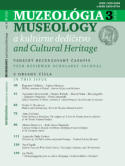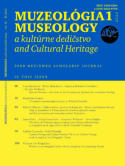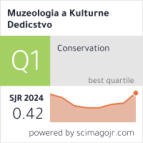

MUZEOLÓGIA
MUSEOLOGY
a kultúrne dedičstvo
and Cultural Heritage

News
Journal Muzeológia a
kultúrne dedičstvo -
Museology and Cultural
Heritage:
SJR 2024: 0,424 (Q1)
Museology SJR rank: 8/83 (Q1) Conservation SJR rank: 11/103 (Q1)JIF WoS 2023: 0,6
JCI WoS 2023: 1,28, Q1 ESCI: 49/411 (Q1)New issue
Muzeológia a kultúrne
dedičstvo 1/2025
online New volume Studia Museologica Slovaca, vol. 8 (2024) online New volume Populačné štúdie Slovenska 17 (2024) onlineNew book
P. Tišliar (ed.). Osobnosti uměleckoprůmyslového muzejnictví (2025). online
Contents 1/2022
Title: Open-air Museums – the Future of the Presentation of Spiritual and Architectural Heritage
Abstract: The origins of “open-air museums” date back to the nineteenth century and from the very beginning were closely linked to
efforts to capture, preserve and present folk culture. However, during the course of the twentieth century, especially in its later part, the
concept of open-air museums began to expand. Open-air museums were founded that focused on urban, industrial and military
environments, ecological issues, or on charting the life of prehistoric and ancient cultures. Along with this, the methodological concept
for this specific type of institution saw some development, and the interdisciplinary approaches expanded in response, covering a wide
range of humanities as well as natural sciences. Besides the academic approach, a social and community overlap is also required
from these institutions. This article poses the question of how the concept of open-air museums can continue to develop and what
direction the role of presenting cultural heritage in an open landscape could take in the future. The arguments herein are based on the
philosophical and spiritual dimension of man’s dwelling in the world and his relationship to the landscape in which he lives. We believe
that the future of open-air museums should, wherever possible, focus on the preservation of monuments in their historical context and
especially in their natural links in terms of landscape, urbanism and architecture. To ensure this concept remains sustainable, it is
necessary that these monuments be involved in the life of villages and communities, ideally also on the basis of cooperation between
academia and local entities, which are usually villages or municipalities and citizens’ initiatives. Examples of such a direction can be
seen in the founding and running of Rochus Park in the Uherské Hradiště region and in the concept of the association of villages
called Mariánská zahrada in the Jičín region, both in the Czech Republic.
Authors: Rychnová, Lucie; Maturkanič, Patrik; Slobodová Nováková, Katarína; Pavlíková, Martina
Publication order reference: University of Chemistry and Technology in Prague, Faculty of Chemical Technology, Department of
Chemical Technology of Monument Conservation, Czech Republic, e-mail: Lucie.Rychnova@vscht.cz, ORCID: 0000-0003-4936-5177;
Comenius University in Bratislava, Faculty of Roman Catholic Theology of Cyril and Methodius, Kapitulská 26, 814 58 Bratislava,
Slovakia, e-mail: maturkanic@frcth.uniba.sk, ORCID: 0000-0002-1087-3847; Department of Ethnology and World Studies, University
of Ss. Cyril and Methodius in Trnava, Námestie J. Herdu 2, 917 01 Trnava, Slovakia, e-mail: katarina.novakova@ucm.sk, ORCID:
0000-0002-8331-7040; Department of Journalism, Faculty of Arts, Constantine the Philosopher University in Nitra, B. Slančíkovej 1
949 74 Nitra, Slovakia, e-mail: mpavlikova@ukf.sk, ORCID: 0000-0002-6738-3320
Source: Muzeológia a kultúrne dedičstvo, year: 2022, vol.: 10, number: 1, pages: 5-18.
Key words: open-air museums; vernacular architecture; countryside; landscape; national heritage; Czech and Slovak Republic
Language: English
online full-text PDF
DOI: 10.46284/mkd.2022.10.1.1
Title: The forgotten metamuseological concepts of Wojciech Gluziński
Abstract: Wojciech Gluziński’s metamuseological concepts, developed in the 1960s and 1970s, found their fullest expression in the
book U podstaw muzeologii [On the fundamentals of museology] from 1980. Its author was then considered to be one of the pioneers
of museological theory in the world. Nevertheless, he is now almost forgotten. This is evidenced by the latest publications of ICOFOM
dealing with the history of twentieth-century museology, which exclude Gluziński. The reason for this lack is the language barrier,
which makes it difficult to evaluate his achievements in terms of content. The recognition of this state of affairs was the reason for the
preparation of this review article using the methods of analysis and criticism of the literature, for which the basis was sources and
studies available only in Polish. The basic questions boiled down to how Gluziński understood the museum and what, according to
him, the subject of museology was. The answer to the first question was the concept of a “pure” museum, while to the second, the
concept of “museum sense”.
Author: Magdalena Lorenc
Publication order reference: Adam Mickiewicz University, Department of Political Science and Journalism, ul. Uniwersytetu
Poznańskiego 5, 61-614 Poznań, Poland, e-mail: magdalena.lorenc@amu.edu.pl, ORCID: 0000-0002-3865-219X
Source: Muzeológia a kultúrne dedičstvo, year: 2022, vol.: 10, number: 1, pages: 19-31.
Keywords: Wojciech Gluziński, museum sense, pure museum, history of museology, twentieth-century museology
Language: English
online full-text PDF
DOI: 10.46284/mkd.2022.10.1.2
Title: Study of foundations in Ukraine from the eleventh to eighteenth centuries and their
preservation and conservation methods: Experiences
Abstract: This paper is a report on experience collected during archaeological studies of structures in the territory of Ukraine. It
discusses the archaeological study of architectural monuments over the period of the operation of the Ukrrestavratsiia Corporation and
presents the observation that most known varieties of masonry systems, featuring different combinations of materials and mortars,
were observed in findings dated to the period of the Kyivan Rus, and that the list of foundation schemes present was limited to a few
types. It was also found that of the schemes observed, the Old Russian scheme displayed an evolution. The study also highlights the
significance of the role of foundation musealisation in the restoration and reconstruction of damaged architectural monuments.
Authors: Mykola Orlenko; Yulia Ivashko; Justyna Kobylarczyk; – Dominika Kuśnierz-Krupa
Publication order reference: Honorary President of the Ukrrestavratsiia Corporation, Kyiv National University of Construction and
Architecture, Ukraine, e-mail: n_orlenko2012@ukr.net, ORCID:0000-0002-4154-2856; Kyiv National University of Construction and
Architecture, Ukraine, e-mail: yulia-ivashko@ukr.net, ORCID: 0000-0003-4525-9182; Cracow University of Technology, Faculty of
Architecture, Poland, e-mail: justyna.kobylarczyk@pk.edu.pl, ORCID: 0000-0002-3358-3762; Cracow University of Technology,
Faculty of Architecture, Poland, e-mail: dkusnierz-krupa@pk.edu.pl, ORCID: 0000-0003-1678-4746
Source: Muzeológia a kultúrne dedičstvo, year: 2022, vol.: 10, number: 1, pages: 33-51.
Keywords: archaeological research, architectural monuments, foundations, structural schemes, Kyivan Rus.
Language: English
online full-text PDF
DOI: 10.46284/mkd.2022.10.1.3
Title: The role of the Protestant legacy in shaping Lower Silesian cultural heritage as exemplified by
the refuge church in Borek Strzeliński (Großburg)
Abstract: Protestant refuge churches were built in Silesian Protestant principalities, and in the borderline areas of Saxony,
Brandenburg and Poland before the end of Thirty Years’ War and the signing of the Peace of Westphalia. In the most part, the
churches were erected by means of adapting Catholic churches to the needs of Protestant believers, e.g. by building emporas (choir
galleries), a pulpit and an altar inside the church. The acquisition of churches in Silesia was peaceful, without any violence almost
everywhere, and it was not a rare phenomenon that a single church was used by two religions at the same time. At the end of the
eighteenth century, there were approximately 110 refugee churches in Silesia. Currently, there are no churches of this type in Lower
Silesia, and their extraordinary decoration was preserved in only a few of them. The main aim is to analyse this specific, forgotten
sacral Protestent heritage, i.e. refuge churches in Lower Silesia, from the historical, sociological and architectural perspective. The
main objective is to focus on the historical importance of the refuge churches in Lower Silesia – restoring identity as exemplified by the
church in Großburg (Polish: Borek Strzeliński), analyse the degree to which the Protestant cultural legacy was preserved in the
material rural architecture of Großburg and analyse the acceptance of the Evangelical heritage in the mentality of the local community.
Authors: Janusz Łach; Alicja Krzemińska; Krzysztof Widawski; Anna Zaręba
Publication order reference: University of Wrocław, Faculty of Earth Sciences and Environmental Management, Institute of
Geography and Regional Development, pl. Uniwersytecki 1, 50–137, Wrocław, Poland, e-mail: janusz.lach@uwr.edu.pl, ORCID: 0000-
0001-8451-5957; e-mail: alicja.krzeminska@uwr.edu.pl, ORCID: 0000-0002-8410-4952; e-mail: krzysztof.widawski@uwr.edu.pl,
ORCID: 0000-0001-6223-3860; e-mail: anna.zareba@uwr.edu.pl, ORCID: 0000-0002-0291-7221
Source: Muzeológia a kultúrne dedičstvo, year: 2022, vol.: 10, number: 1, pages: 53-78.
Keywords: Lower Silesia, Borek Strzeliński (German: Großburg), refuge church, sacred landscape, Protestantism
Language: English
online full-text PDF
DOI: 10.46284/mkd.2021.10.1.4
Title: Cultural Heritage and Cultural Potential: The Use of Cultural Heritage on the Example of an
Ethnographic Group
Abstract: The formation and use of the cultural heritage and identity of local communities is a result of historical development and
current opportunities and needs. Cultural heritage becomes a part of the cultural potential as a system. In Čajkov, the most
representative village of the Slovak Chilejkar people, there is a system of using the established concept of local cultural heritage
through cultural events (several of which are closely connected in terms of organisation and visitors) implemented by local human
resources structured into local organisations and institutions, which are relatively diverse but have an internal logic. Some events have
an old tradition; others originated and became “traditional” only a few years ago.
The outlined system existing in a municipality with less than 1000 inhabitants reflects the degree of functioning of the local community.
It is conditioned by cohesion, hierarchy, the self-confidence of members and appropriate economic conditions. For seniors, besides
routine and tradition, the essential activating element is the social dimension – being socially active means meeting others, spending
time with peers and eliminating loneliness. It is also an important identity creator in the socialisation, education and especially the
upbringing of children and youth.
Authors: Ladislav Lenovský; Lukáš Kurajda
Publication order reference: University of Ss. Cyril and Methodius in Trnava, Faculty of Arts, Department of Ethnology and World
Studies, Nám. J. Herdu 2, 917 01 Trnava, Slovak Republic, e-mail: ladislav.lenovsky@ucm.sk, ORCID: 0000-0003-3059-5036; e-mail:
lukas.kurajda@ucm.sk, ORCID: 0000-0002-0975-2490
Source: Muzeológia a kultúrne dedičstvo, year: 2022, vol.: 10, number: 1, pages: 79-104.
Keywords: cultural heritage, cultural potential, ethnographic group, Chilejkars, Čajkov
Language: English
online full-text PDF
DOI: 10.46284/mkd.2022.10.1.5
Title: Workers in an ethnographic archive: On the strategies of (re-)constructing the past
Abstract: The article describes a collection of 9,000 photographs with captions – entries to a worker-oriented photographic contest –
and the paths by which they came from private albums through the contest and museum exhibitions, until they found a place in the
ethnographic archive of the Łódź University and in a digital repository. Having left household archives, they became a part of a public
heritage rooted in, and dependent on, various historical contexts. Each procedure in some way determined the fortunes of the
collection and constituted a choice that imparted a certain shape and meaning to the photographs.
Author: Grażyna Ewa Karpińska
Publication order reference:University of Lodz, Faculty of Philosophy and History, Institute of Ethnology and Cultural Anthropology,
Poland, e-mail: grazyna.karpinska@uni.lodz.pl, ORCID 0000-0003-2102-774X
Source: Muzeológia a kultúrne dedičstvo, year: 2022, vol.: 10, number: 1, pages: 105-117.
Keywords: ethnographic archive, workers, photographs, digital repository Workers in the 19th and 20th century, heritage
Language: English
online full-text PDF
DOI: 10.46284/mkd.2022.10.1.6
Books received and reviews
Ľuboš Kačírek: Michal Milan Harminc – museum builder (p. 119) online full-text PDF
Articles (Abstracts)

Full-text version
DOI:10.46284/mkd.2022.10.1.0
ISSN 1339-2204
eISSN 2453-9759
Vol. 10 (2022), No. Is. 1



























